Measurement and Mitigation of Radon Concentration in a Traditional Dwelling in Galicia, Spain
Abstract
1. Introduction
2. Materials and Methods
2.1. Location of the Building
2.2. Type and Morphology
2.3. Identification of Sources
2.4. Measurement Strategies
2.5. Mitigation Strategy
2.6. Installation of the Device
2.7. Prior Operations to Prepare the Building
3. Results and Discussion
Results of the Corrective Measure
4. Conclusions
5. Patents
Author Contributions
Funding
Institutional Review Board Statement
Informed Consent Statement
Conflicts of Interest
References
- Barros-Dios, J.; Barreiro, M.; Ruano-Ravina, A.; Figueiras, A. Exposure to residential radon and lung cancer in Spain: A population-based case-control study. Am. J. Epidemiol. 2002, 156, 548–555. [Google Scholar] [CrossRef] [PubMed]
- Samet, J.M.; Eradze, G.R. Radon and Lung Cancer Risk: Taking Stock at the Millenium. Environ. Health Perspect. 2000, 108, 635–641. [Google Scholar] [CrossRef] [PubMed][Green Version]
- Hill, D.; Auvinen, A.; Barros-Dios, J.; Baysson, H.; Bochicchio, F.; Deo, H.; Falk, R.; Forastiere, F.; Hakama, M.; Heid, I.; et al. Radon in homes and risk of lung cancer: Collaborative analysis of individual data from 13 European case-control studies. BMJ 2005, 330, 223. [Google Scholar] [CrossRef]
- Branion-Calles, M.; Nelson, T.; Henderson, S. A geospatial approach to the prediction of indoor radon vulnerability in British Columbia, Canada. J. Exp. Sci. Environ. Epidemiol. 2015, 26, 554–565. [Google Scholar] [CrossRef] [PubMed]
- Zeeb, H.; Shannoun, F.; Organización Mundial de la Salud. Manual de la OMS sobre el Radón en Interiores: Una Perspectiva de Salud Pública. Organización Mundial de la Salud. 2015. Available online: https://apps.who.int/iris/handle/10665/161913 (accessed on 2 August 2021).
- Frutos, B.; Olaya, M.; Esteban, J.L. Sistemas de extracción como técnicas constructivas para evitar la entrada de gas radón en las viviendas. Inf. Constr. 2011, 63, 23–36. [Google Scholar] [CrossRef]
- Public Health England. UKradon—How to Reduce Radon Levels. 2021. Available online: https://www.ukradon.org/information/reducelevels (accessed on 2 August 2021).
- International Atomic Energy Agency. Protection against Exposure Due to Radon Indoors and Gamma Radiation from Construction Materials—Methods of Prevention and Mitigation. International Atomic Energy Agency. 2021. Available online: https://www.iaea.org/publications/14817/protection-against-exposure-due-to-radon-indoors-and-gamma-radiation-from-construction-materials-methods-of-prevention-and-mitigation (accessed on 2 August 2021).
- Chazarra Bernabé, A.; Flórez García, E.; Peraza Sánchez, B.; Tohá Rebull, T.; Lorenzo Mariño, B.; Criado Pinto, E.; Moreno García, J.V.; Romero Fresneda, R.; Botey Fullat, R. Mapas Climáticos de España (1981–2010) y ETo (1996–2016)—Agencia Estatal de Meteorología—AEMET. Gobierno de España. Área de Climatología y Aplicaciones Operativas. 2018. Available online: http://www.aemet.es/es/conocermas/recursos_en_linea/publicaciones_y_estudios/publicaciones/detalles/MapasclimaticosdeEspana19812010 (accessed on 2 August 2021).
- Consejo de Seguridad Nuclear. Mapa del Potencial de Radón en España—CSN. 2017. Available online: https://www.csn.es/mapa-del-potencial-de-radon-en-espana (accessed on 2 August 2021).
- de Llano, P. Arquitectura Popular en Galicia; COAG: Santiago de Compostela, Spain, 1981. [Google Scholar]
- Frutos Vázquez, B.; Muñoz Lorenzo, E. Radon en la Edificacion. Tecnicas de mitigacion. In Proceedings of the Jornada de Contaminación por Gas Radón. Avances y Desarrollos en el Ámbito de la Protección, Madrid, Spain, 14 December 2016. [Google Scholar]
- Quindós Poncela, L.S. Radón: Un Gas Radiactivo de Origen Natural en Su Casa; Consejo de Seguridad Nuclear: Madrid, Spain, 1995. [Google Scholar]
- Agencia Estatal Boletín Oficial del Estado (AEBOE). Real Decreto 732/2019, de 20 de Diciembre, por el Que se Modifica el Código Técnico de la Edificación, Aprobado por el Real Decreto 314/2006, de 17 de Marzo, Pub. L. No. Real Decreto 732/2019, BOE-A-2019-18528 140488. 2019. Available online: https://www.boe.es/eli/es/rd/2019/12/20/732 (accessed on 2 August 2021).
- Ramirez Fernandez, M.P.; Moron Fernandez, C.; García García, A.; Correa, E. Estudio de las Concentraciones y Mecanismos de Desplazamiento de Radón y Descendientes en Recintos Cerrados. Actas del Congreso de Innovación Tecnológica en la Edificación CITE—2011. Madrid, España, 179–184. 2011. Available online: http://oa.upm.es/13446/ (accessed on 2 August 2021).
- Rabago, D.; Fuente, I.; Celaya, S.; Fernandez, A.; Fernandez, E.; Quindos, J.; Pol, R.; Cinelli, G.; Quindos, L.; Sainz, C. Intercomparison of Indoor Radon Measurements Under Field Conditions In the Framework of MetroRADON European Project. Int. J. Environ. Res. Public Health 2020, 17, 1780. [Google Scholar] [CrossRef] [PubMed]
- Pol, R.; Rodríguez, R.; Quindos, L.; Fuente, I. Mitigation Techniques for Interior Radon in Refurbishment Work in High Radiation Areas of Galicia: An Experimental Model to Test Building Solutions. Civ. Environ. Eng. 2021, 17, 485–499. [Google Scholar] [CrossRef]
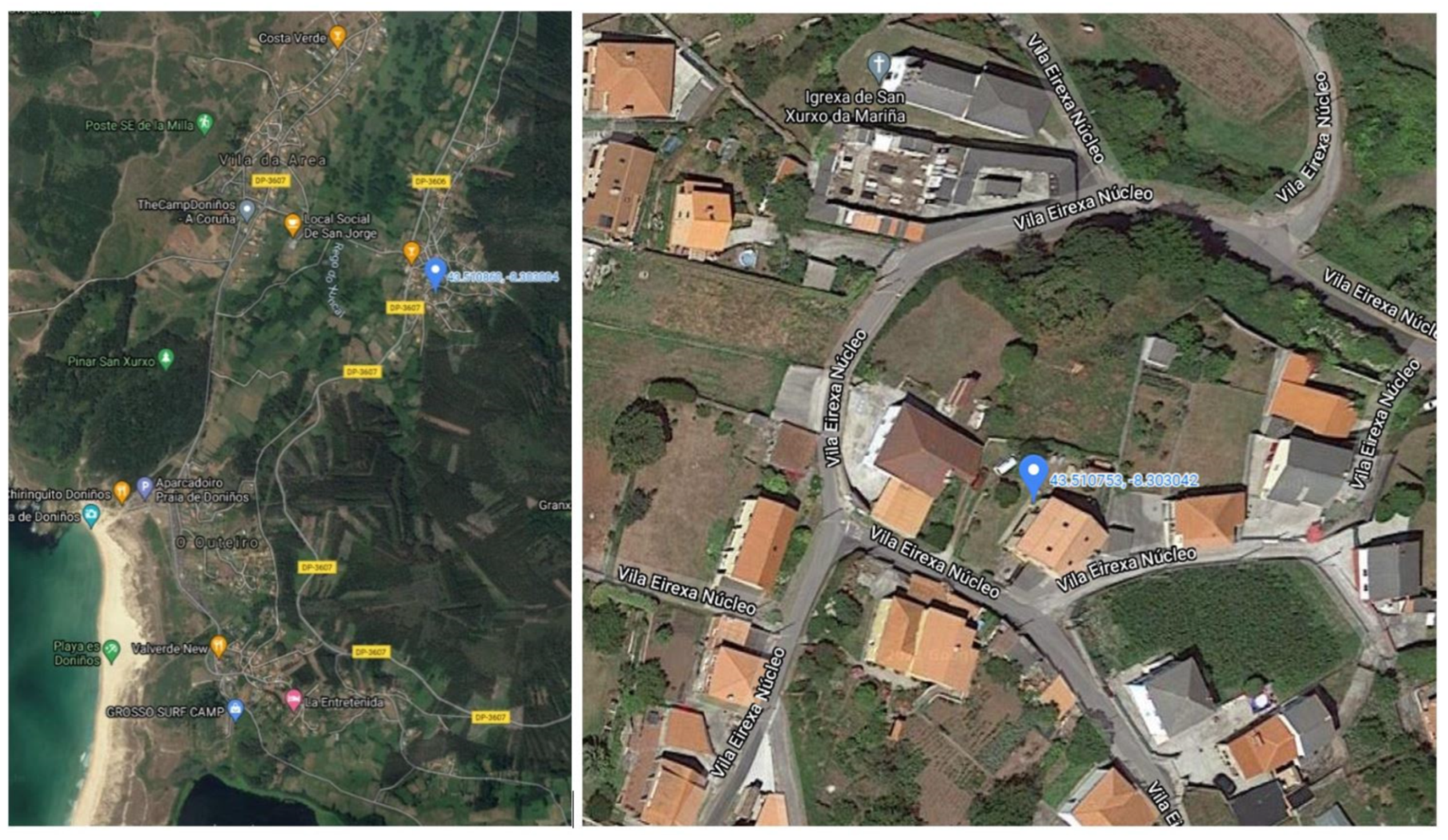
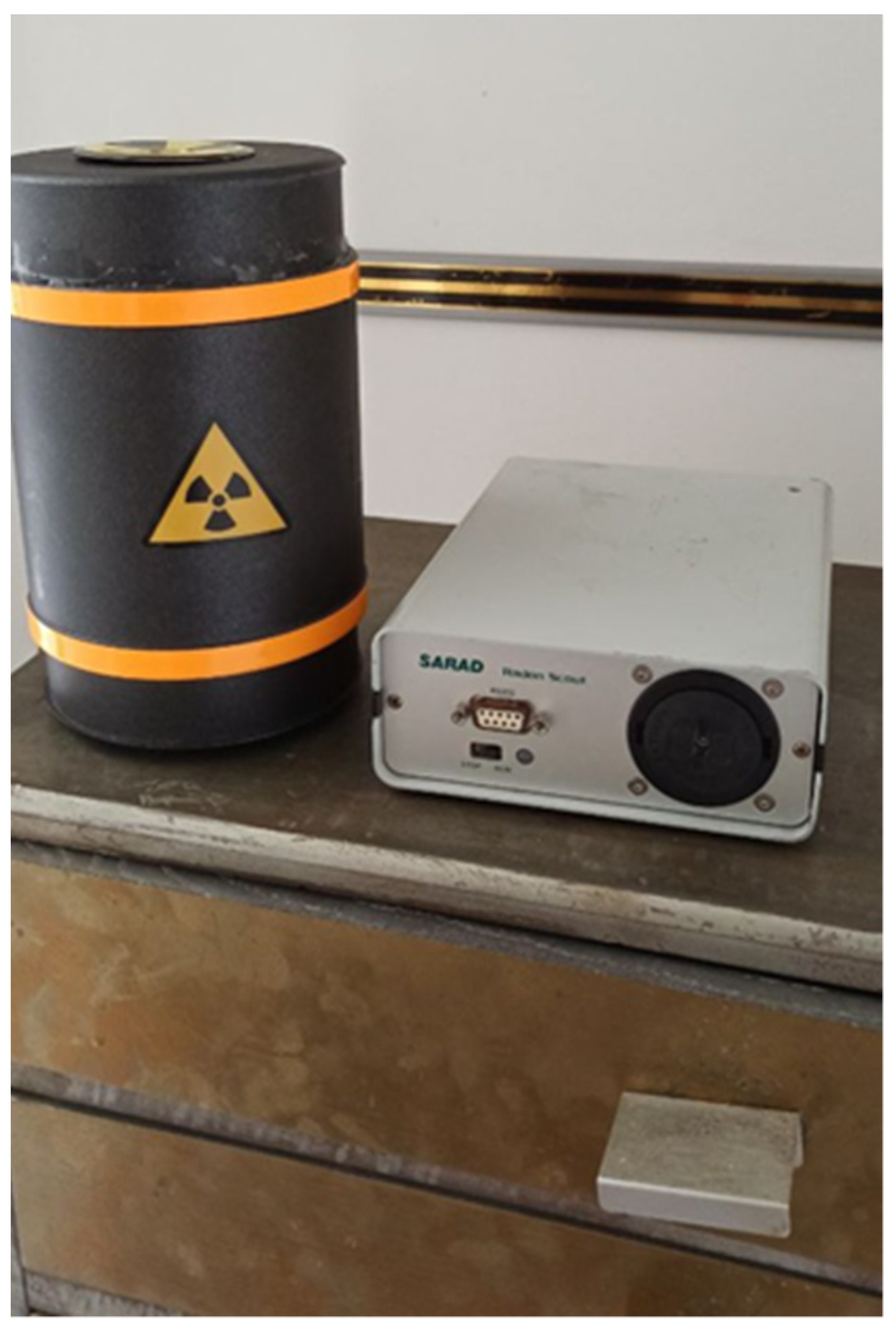
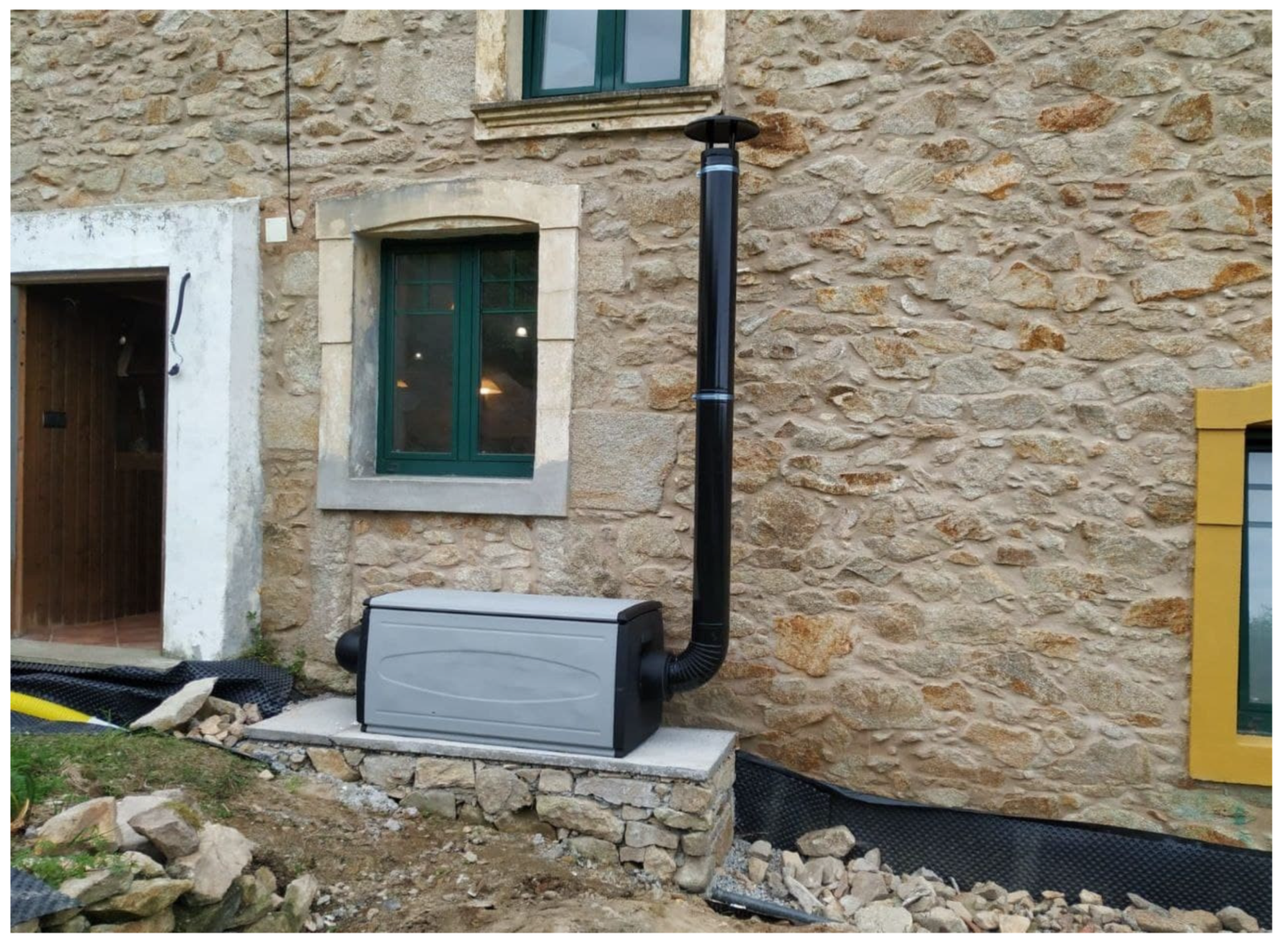
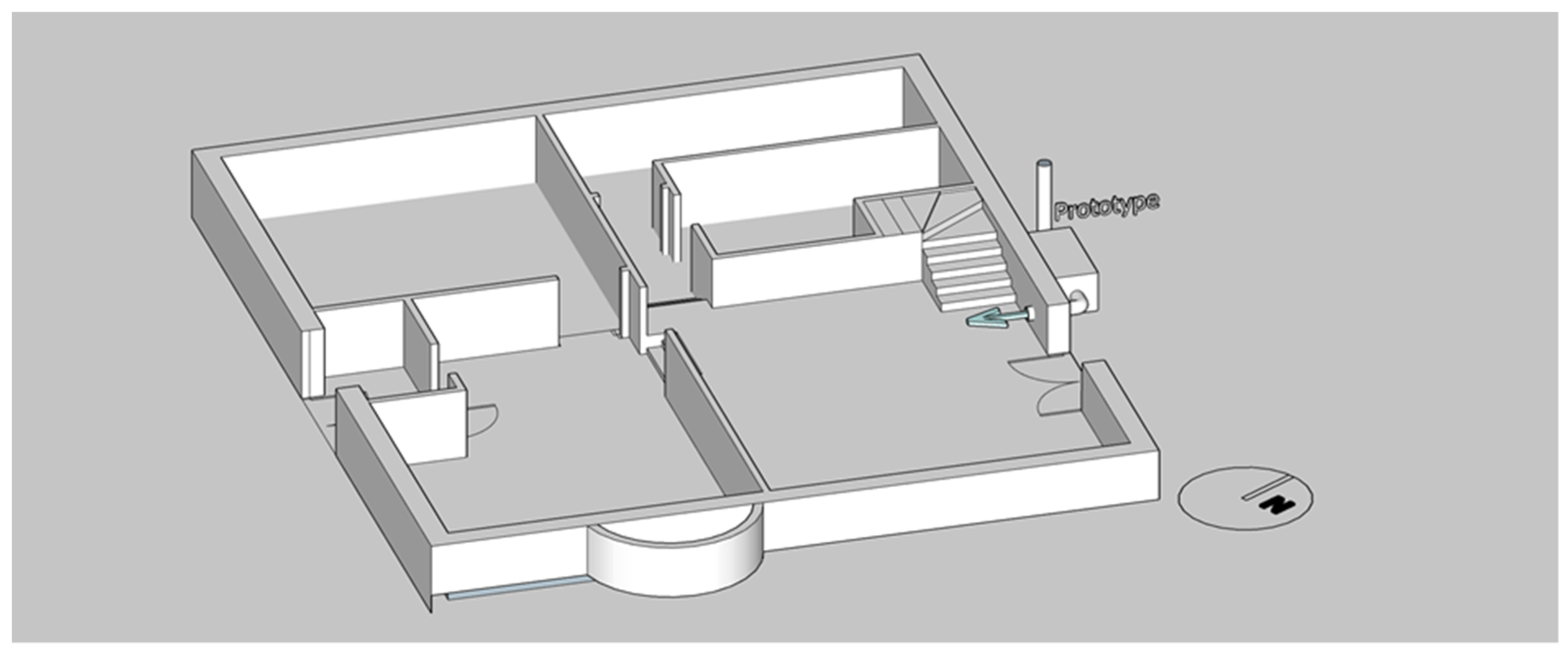
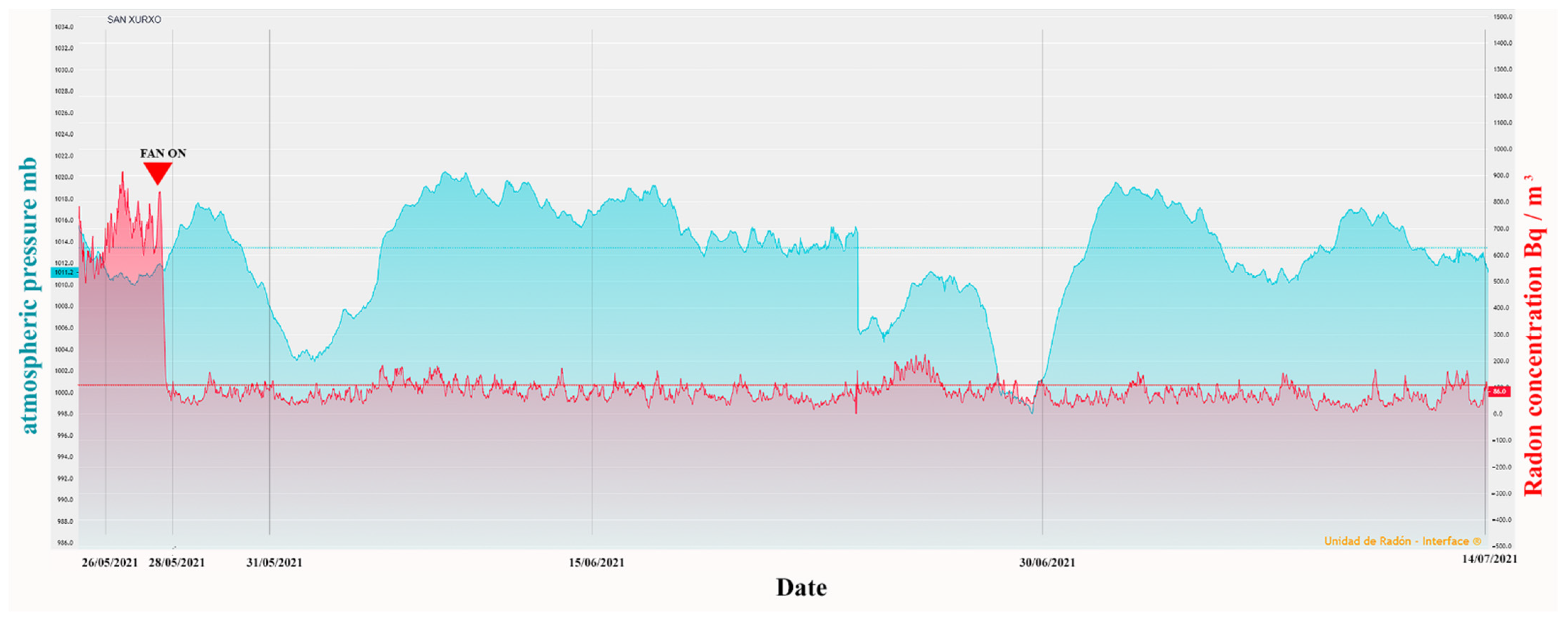
Publisher’s Note: MDPI stays neutral with regard to jurisdictional claims in published maps and institutional affiliations. |
© 2021 by the authors. Licensee MDPI, Basel, Switzerland. This article is an open access article distributed under the terms and conditions of the Creative Commons Attribution (CC BY) license (https://creativecommons.org/licenses/by/4.0/).
Share and Cite
Pol, R.; Rodríguez, R.; Quindós, L.S.; Fuente, I. Measurement and Mitigation of Radon Concentration in a Traditional Dwelling in Galicia, Spain. Atmosphere 2022, 13, 14. https://doi.org/10.3390/atmos13010014
Pol R, Rodríguez R, Quindós LS, Fuente I. Measurement and Mitigation of Radon Concentration in a Traditional Dwelling in Galicia, Spain. Atmosphere. 2022; 13(1):14. https://doi.org/10.3390/atmos13010014
Chicago/Turabian StylePol, Ricardo, Raúl Rodríguez, Luis Santiago Quindós, and Ismael Fuente. 2022. "Measurement and Mitigation of Radon Concentration in a Traditional Dwelling in Galicia, Spain" Atmosphere 13, no. 1: 14. https://doi.org/10.3390/atmos13010014
APA StylePol, R., Rodríguez, R., Quindós, L. S., & Fuente, I. (2022). Measurement and Mitigation of Radon Concentration in a Traditional Dwelling in Galicia, Spain. Atmosphere, 13(1), 14. https://doi.org/10.3390/atmos13010014





